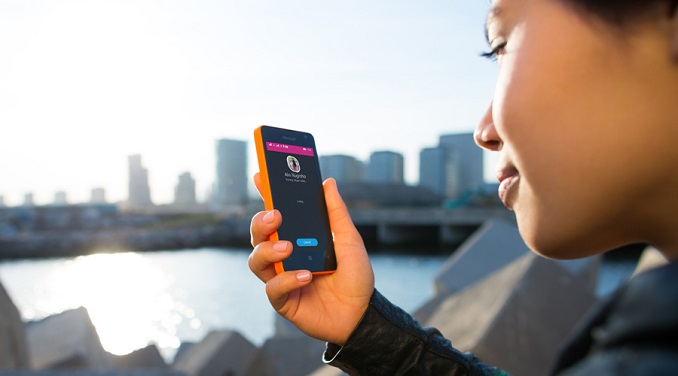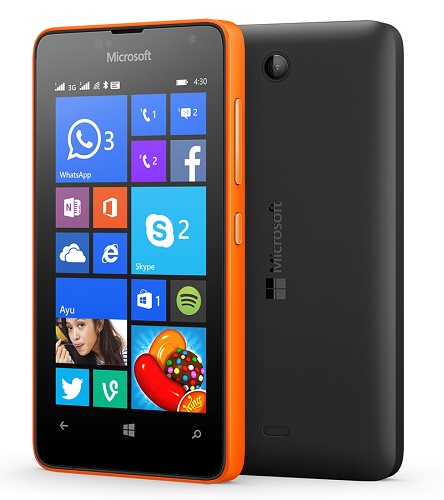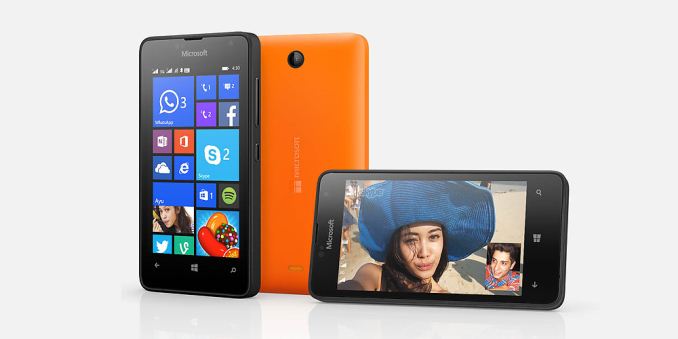Microsoft Launches The Ultra Low Cost Lumia 430
by Brett Howse on March 19, 2015 11:10 PM EST- Posted in
- Smartphones
- Microsoft
- Lumia

To say that the Lumia brand is diluted with low cost smartphones would be a bit of an understatement. However, Microsoft has found a way to lower the barrier to entry even further with the launch of the Dual-SIM Lumia 430 model today.
It is all fairly pedestrian in the specifications department, as we will see below, but the real story is just how inexpensive this device is. Pricing will vary by market, but Microsoft is estimating the Lumia 430 Dual-SIM smartphone to be priced around $70 USD before any subsidies are applied.
To hit these kinds of price points, some sacrifices have to be made of course, but all in all it is still a typical low end Lumia. Before Microsoft bought the Lumia line from Nokia, we had similar low end phones launched that would be missing key features. The Lumia 635 is a great example of this. Although it was a decent device, the lack of a proximity sensor and ambient light sensor made it difficult to use in real life, and the limited 512 MB of RAM meant it could not access the entire Windows Phone catalog of apps.
Microsoft has taken a different approach, and all of the low end devices that they have launched with the Microsoft logo have included the standard features needed to enjoy a smartphone experience, and the $70 Lumia 430 is no exception. It comes with the Qualcomm Snapdragon 200 SoC, with dual 1.2 GHz Cortex A7 cores, so it will not be the speediest device ever launched, but Windows Phone has always been good on low end devices and avoids the stutter and chop which has plagued Android. RAM is a healthy 1 GB, which means that the Lumia 430 does have access to the entire Windows Phone store. Other key features such as the ambient light and proximity sensor are included, even for this budget price, so obvious features such as automatic brightness will work.
Speaking of brightness, the LCD will also likely be a very low end model, but it is a 4” 800x480 LCD, although it is not listed whether this is an IPS display (hopefully it is) but the display enhancement technologies such as ClearBlack are not available. I have also found with the low end Lumia phones that the display coating is also either very thin or not available, and this could continue that trend due to the price.
Storage is also something that Microsoft has bumped up, with Nokia opting for 4 GB on the very low end models, but Microsoft has equipped even this low end device with 8 GB of internal NAND. MicroSD support will give an additional 128 GB more space, and Windows Phone supports MicroSD very well so this will not be an issue.
The battery is just a 1500 mAh, with the older 3.7 V chemistry, which works out to just 5.55 Wh of capacity.
| Nokia Lumia 430 | |
| SoC | MSM8212 dual-core 1.2 GHz Snapdragon 200 |
| RAM/NAND | 1 GB RAM, 8 GB NAND + microSD |
| Display | 4.0” 800x480 LCD |
| Network | GSM/GPRS/EDGE/UMTS/HSPA+ up to 42.2 Mbps |
| Dimensions | 120.5 x 63.2 x 10.6 (mm) |
| Weight | 127.9 grams |
| Camera | 2MP rear camera Fixed Focus 1/5" Sensor No Flash, VGA FFC |
| Battery | 1500 mAh (5.55 Whr) |
| OS | Windows Phone 8.1 with Denim Firmware |
| Connectivity | 802.11 b/g/n + BT 4.0, USB2.0, MPT, DLNA, FM Radio |
| Location Technologies | Cellular and Wi-Fi network positioning, A-GPS, A-GLONASS |
| SIM Size | Smart Dual MicroSIM |
The camera is the main area where costs were saved. The Lumia 430 comes with just a 2 MP fixed focus camera on the rear, however the front camera is the same resolution as the $1299 Apple MacBook, with a 0.3 MP VGA sensor which is clearly for cost savings, and will not be very good for anything other than the occasional video chat.
Microsoft’s strategy seems to be to release a new low end smartphone every couple of weeks, and even as someone who follows the space it is getting awfully confusing. However most of these are aimed at specific markets, and the Lumia 430 is no exception. The Lumia 430 will be available in April in the Asia-Pacific, India, the Middle East, Africa, Russia, Kazakhstan, Ukraine and Belarus.
Source: Lumia Conversations












60 Comments
View All Comments
Alexvrb - Sunday, March 22, 2015 - link
I try not to support Mediatek. I don't want their junk creeping into mid-range devices. Keep it in disposable devices with poor build quality, like those sub-$50 tablets.Michael Bay - Monday, March 23, 2015 - link
I`ve had a Mediatek SoC phone before moving on to WinPhone, and it was okay performance-wise and in battery times. True, GPS was bad, but that`s about it.Furunomoe - Tuesday, March 24, 2015 - link
Where you can get an Android One phone for only Rp 699,000? The cheapest one I could find is the Rp 999,000 (~ US$77) Nexian Journey One, the other two models are even more expensive.Granted, it is not a bad phone, I have one myself. Everything is pretty smooth considering the price and I don't feel disadvantaged when comparing the usability to higher-end phones.
Wolfpup - Friday, March 20, 2015 - link
This sounds like an astonishingly good phone for the price! If AT&T picks it up it could well end up cheaper, because like the 635 that's supposedly $180 or whatever actually goes for $50 most of the time (and $100 before that).I disagree with the comments regarding the 635. I've had multiple flagship phones and tablets, and on some of them auto-brightness doesn't really work at all (and on all of them I have to adjust it manually regardless sometimes), and it's super easy to adjust on the 635 regardless...the middle setting is normally fine for everything. And the proximity sensor is always flaky from my experience too, so not having one doesn't seem like much of a loss. On my iPhone 5s and others I'd often have to wait for the sensor to decide it wasn't near me anymore, sometimes hold it back up, put it back down, etc.
Anyway both features aren't really anything I miss on my 635.
Michael Bay - Friday, March 20, 2015 - link
But there must be a proximity sensor on 635.I`ll have to check 435, but I think it was there too.
Gunbuster - Friday, March 20, 2015 - link
With the 635 dipping into the $30 range is the 430 going to to be $20 on sale? $15?cheshirster - Thursday, May 7, 2015 - link
+630Brett Howse is just another theorist, that do not want to learn how really successful budget phones should be done.
Calista - Friday, March 20, 2015 - link
Why oh why did they not add an LED flash? What could it possible cost, 50 cent? I bought the Lumia 520 when it was new to try out Windows Phone. And while I could live with the small screen, low ram, slow CPU and basic camera the single thing that made me sell it was the lack of any kind of flash.It's quite simple - many of the countries this phone will be sold in are really poor. Poor countries have often bad lightning both inside and outdoors. As in a single naked light-bulb in a room. This makes a phone without a flash useless more often than not.
The only logical reason I can think of not to include a flash is to further segment the market. But that's being greedy, not a very charming quality.
whatsa - Friday, March 20, 2015 - link
Honestly if that's what your house is like then get a dumb phone for $20 and usethe other $50 for a few things around the house (lights) and other things that benefit the whole
family. You don't really need a SP and a $100 mini laptop the whole family could use is a better investment.
Calista - Sunday, March 22, 2015 - link
Why do you assume I'm poor/living in a poor country? And besides, you never tried to refute my point. It's quite simple, a LED flash is a very inexpensive but at the same time very useful addition to a phone.